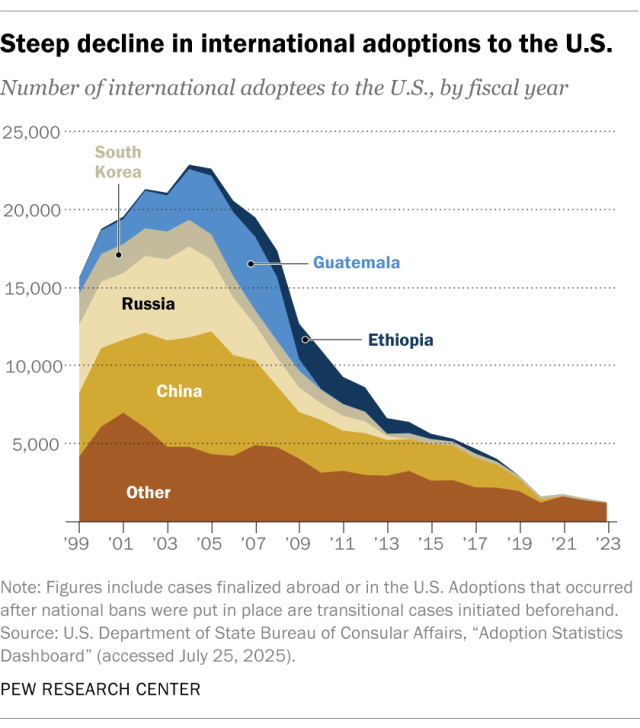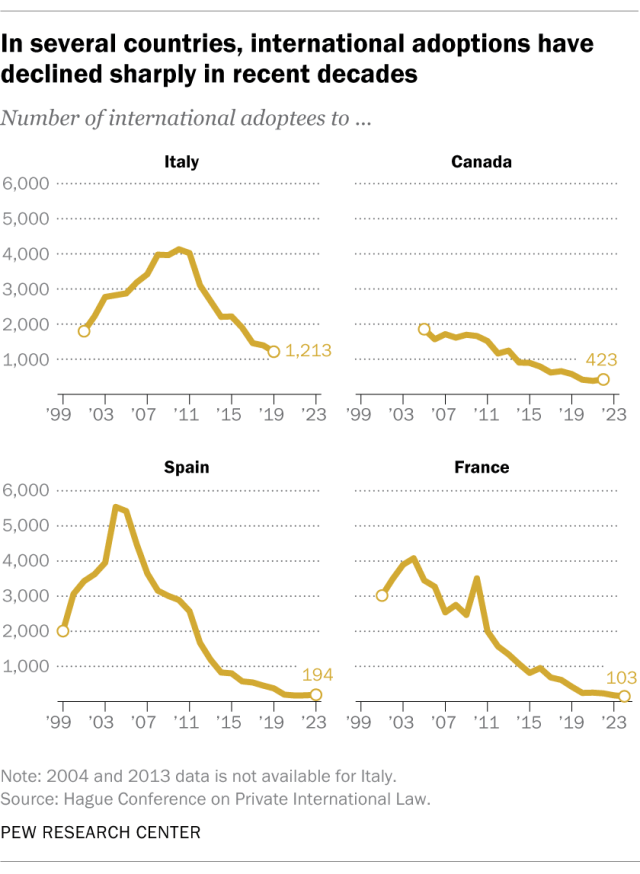After peaking in 2004, the annual number of international adoptions to the United States has fallen by 94% as of 2023, according to the most recent available U.S. State Department data.

The State Department recorded 22,988 international adoptions to the U.S. in fiscal year 2004. That number dropped to 1,275 in fiscal 2023.
International adoptions have also decreased as a share of all adoptions in the U.S.
Since 1999, most international adoptees to the U.S. have come from one of five countries: China (29%), Russia (16%), Guatemala (10%), South Korea (8%) or Ethiopia (6%). All five have moved to limit international adoptions in recent years:
- Lawmakers in China and Ethiopia banned foreign adoptions in 2024 and 2018, respectively.
- Russia has prohibited U.S. citizens from adopting there since 2013, and last year it enacted bans affecting a number of other countries. Regional media outlets have reported that no Russian children were adopted internationally in 2024.
- Guatemala halted international adoptions starting in 2008 amid concerns about corruption and child trafficking.
- South Korea announced in July that it would end all private international adoptions after a government probe found irregularities going back decades.
International adoptions to other countries

The U.S. is not alone in its sharp decline in international adoptions. Several other countries that recorded many such adoptions in the past – including Canada, France, Italy and Spain – have also seen steep decreases over the last two decades, according to data collected by the Hague Conference on Private International Law (HCCH).
For example, the number of international adoptions in France peaked in 2004 at 4,079, but that figure fell to 103 in 2024 – a 97% decrease. The trend is similar in Spain, where international adoptions declined 96% between 2004 and 2023, the most recent year with data available.
Some countries have also restricted their own citizens’ ability to adopt children internationally. In December 2024, the Netherlands announced a plan to phase out adoptions from other countries by 2030. Denmark also effectively ended these adoptions when the country’s only international adoption agency closed early last year.
How are international adoptions regulated?
The U.S. and the members of the European Union are among the dozens of countries that are part of the 1993 Hague Convention, which established ethical standards for foreign adoption to ensure adoptees’ best interests and safeguard against child trafficking.
Adoptions both to and from Hague Convention countries are overseen by a network of centralized government authorities. Key requirements must be met in order for these adoptions to go ahead, including parental consent and “due consideration” of placements in the child’s country of origin.
In contrast to the slowing rate of international adoptions, international surrogacy – involving a surrogate and intended parents from different countries – is reportedly on the rise. There is no international governing body responsible for regulating these arrangements, and the legality of surrogacy in general varies widely by country.
